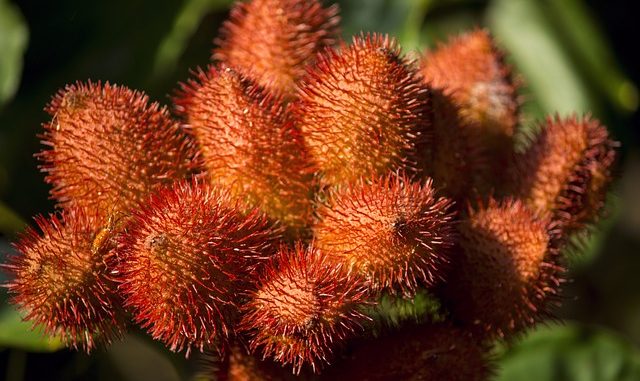
Annatto is the name of a colour but is also the name of the seeds that come from a tropical bush called Bixa orellana. The major colour compound in annatto is cis-bixin which is the monomethyl ester of the diapocarotenoic acid known as norbixin. Bixin makes up 80 per cent of the total pigment content.
The proper name of norbixin is 9′-cis-6,6′-diapocarotene-6,6′-dioic acid. Norbixin is obtained by saponification of bixin byusing alkaline solutions such as NaOH and KOH to form a salt in polar solvents (Scotter, 2009).
The colour has a long history of use in food manufacturing. The two colours, bixin and norbixin are both oil soluble.
In labelling terms it is known as E160b.
The annatto is a bush growing between 3m and 6m high. It is native to Central and South America where it seeds are used extensively to colour food and clothes. The fruit is a burr-like pod containing between 20 and 50 seeds which are the size of grape seeds. These are covered with a thick layer of soft red pulp which is the source of the colour.
Annatto is also known as orlean, achiote, urucum, rocou. It is cultivated in many tropical countries but especially Mexico, Jamaica, peru, Brazil, Kenya and Phillipines as major centres of supply. Roughly 80 per cent of production of annatto colour is used by the USA and Western Europe. The amount varies between 10K and 11K Tonnes. It is primarily used to colour butter, margarine and cheese.
Historically, annatto was used as a spice to flavour fish, pork, chicken and rice in Mexico but in more recent years now flavours paella, curry and chili products.
Stability
ASLT is often used to examine colour stability over a short period of time as a way of understanding the longer-term stability of the colour. The thermal stability of norbixin and bixin in fresh orange juice was assessed at refrigeration temperatures between 7 and 10 Centigrade and at room temperature of 25 to 30 Centigrade. This was to stimulate storage conditions for a long period of time of 5 months. There was significant loss of norbixin at the higher temperatures. (Prabhakara Rao et al., 2002).
Encapsulation
Annatto, bixin and norbixin have all been stabilised to some extent by microencapsulation.
References
Barbosa, M.I.M.J., Borsarelli, C.D., Mercadante, A.Z., 2005. Light stability of spray-dried bixin encapsulated with different edible polysaccharide preparations. Food Res. Int. 38, pp. 989–994. (Article)
Prabhakara Rao, P.G., Jyothirmayi, T., Balaswamy, K., Satyanarayana, A., Rao, D.G., 2005. Effect of processing conditions on the stability of annatto (Bixa orellana L.) dye incorporated into some foods. LWT Food Sci. Technol. 38, 779–784. (Article) https://dx.doi.org/10.1016/j.lwt.2004.08.015
Prabhakara Rao, P.G., Satyanarayana, A., Rao, D.G., 2002. Effect of storage on the stability of water soluble annatto dye formulation in a simulated orange-RTS beverage model system. LWT Food Sci. Technol. 35, pp. 617–621. (Article)
Scotter, M., 2009. The chemistry and analysis of annatto food colouring: a review. Food Addit. Contam. A Chem. Anal. Control Expo Risk Assess. 26, pp. 1123–1145. (Article)
Leave a Reply